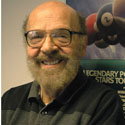 Tips & shafts By George Fels Consulting Editor George Fels has been writing for Billiards Digest since 1980, and his "Tips & Shafts" column is usually our readers' first stop when they crack open the magazine. For better or worse, pool has been his only mistress for 40-plus years.
Archives
Best of Fels
|
|
Feb: Continuous February 2014 [Ed. Note: George was nine months ahead on his Tips & Shafts column at the time of his death. Billiards Digest wouldn't deny his faithful readers the joy of seeing those columns in their rightful place on the last page.]
That's straight pool's formal name, you know: "14.1 Continuous Pocket Billiards." There was even a time, decades ago, when I used the expression as semi-slang: "Hey, y'come to play some Continuous?" The game was invented by one Jerome Keogh in 1910. Prior to that, all 15 balls would be re-racked once the table was cleared; the player at the table then had his choice of blast-break (on that shot only, "slop" counted) or playing a defensive safety. The long run in that particular form of pool (known even back then as Continuous Pocket Billiards) was in the low 90s, by the peerless Alfredo de Oro. Then as now, protracted safety battles were about as stimulating as a six-pack of Nytol, so Keogh innovated leaving the last object ball to stand as though in exile. Oddly, Keogh, who was a world champion before his invention, never won anything playing it.
All this seems worth a re-visit in light of Darren Appleton's becoming the first competitor in straight-pool history to run 200 (actually, 200+) balls in a match of formal standing. Unlike the vast majority of his O.B.E. compatriots, Appleton has relatively little snooker in his background. When America got its first looks at him, he was a reigning British 8-ball champion (played not with conventional balls, but seven reds, seven yellows, and a black). It did not take him long to go two years at the annual U. S. Open 9-ball meet without losing a single match; at the same time and soon after, he had gobbled up every major 9- and 10-ball title in sight, and came within a single cross-corner bank of being our one-pocket champion too. He's clearly already forming a bid to become one of the all-time best.
Appleton lost the 2013 14.1 final to former champion Thorsten Hohmann, whose own run of 174 (on, of all opponents, future champ John Schmidt) was the World Championship's previous best. As straight-pool championship one-on-one challenge matches, with their unique "block-scoring" format, have not been played since the '60s that I know of, this is the only meet where runs of that magnitude could take place. Thus, if Appleton's record is to be broken, it would have to be at this tournament.
But at least Appleton's feat was accomplished in a match of consequence, seen live by some dozens in New York's Steinway Billiards and hundreds more on live stream. Long runs intrigue the game's fans the way tape-measure home runs captivate baseball lovers, and the claims of titanic practice runs are the stuff of legends. The late New Yorker Mike Eufemia's claim to have run 625, witnessed from beginning to end by absolutely nobody, is the most famous of these, and Eufemia was indeed a 14.1 practice genius, who devolved in formal competition to a just plain Ray Charles. Far more accomplished in tournament play was Hall of Famer Art Cranfield, who claimed a monstrous practice run of 768, similarly unconfirmed (although he did run 420 on a 5' x 10' table in a Syracuse exhibition apparently witnessed by many).
Cranfield's Hall of Fame peers Allen Hopkins, Jim Rempe, Dallas West, and even Earl Strickland all claim to have run 400+ balls, yet it is Schmidt who has been designated as "Mr. 400," as though the feat were a regular occurrence for him. But the really intriguing aspect of long practice runs is that the man who made the most of them is also the man who cared about them least.
The immortal Willie Mosconi's disdain for the game that made him famous is quite well-known by now; for the record, he said, "I would no sooner shoot pool in my spare time than a headwaiter would wait tables on his day off." He was similarly unconcerned with how many balls he ran; to him, running out was simply the most direct way to avoid losing, which he hated far more than he loved winning. It was common procedure for him to run 150 or 200 balls in exhibition and immediately sweep up the balls to go into his trick-shot routine (which, if you'd seen it twice or more, was actually somewhat dreary; Mosconi was no entertainer, nor would he have claimed to be, and his patter sounded wooden and rehearsed, using not only the exact same words each time but the exact same inflection too). He once played a three-day exhibition here in town where he ran 200, 200 and 160 and out over the three days, and cut off all three runs himself. His much-heralded run of 526 only came to be because the adoring exhibition crowd in Springfield, Ohio, beseeched him to go on to No. 201 and beyond.
And here's how grotesque his lack of interest in running the balls really was: Charlie Ursitti, who knows far more about Mosconi's accomplishments than Mosconi himself, as well as the rest of the universe, claims to have witnessed this personally. In the late '70s, when Mosconi would have been in his mid-'60s, he was taping a brief series for CBS-TV in which he performed with "Minnesota Fats" Wanderone and others. One night, seemingly with nothing better to do, he ran an impeccable 42 racks (that's 588, but who's counting?), scorched the break shot for rack No. 43, and, with a run of 589 and 14 more balls sitting wide-open, laid his cue on the table and said to Ursitti, "Let's go get some dinner. See, it's no big deal to run 600 balls."
Depends on your point of view, I guess. But to the dozens of guys I know - and you can easily make that thousands, on a worldwide basis - who show up regularly at their room of choice hoping to put together a mere couple of racks, not just so they can win a few bucks but go home feeling absolutely magical, masterful, wonderful, it's a very, very big deal indeed. Clearly Mosconi did not know the joy he was missing out on. And that's his loss. |





